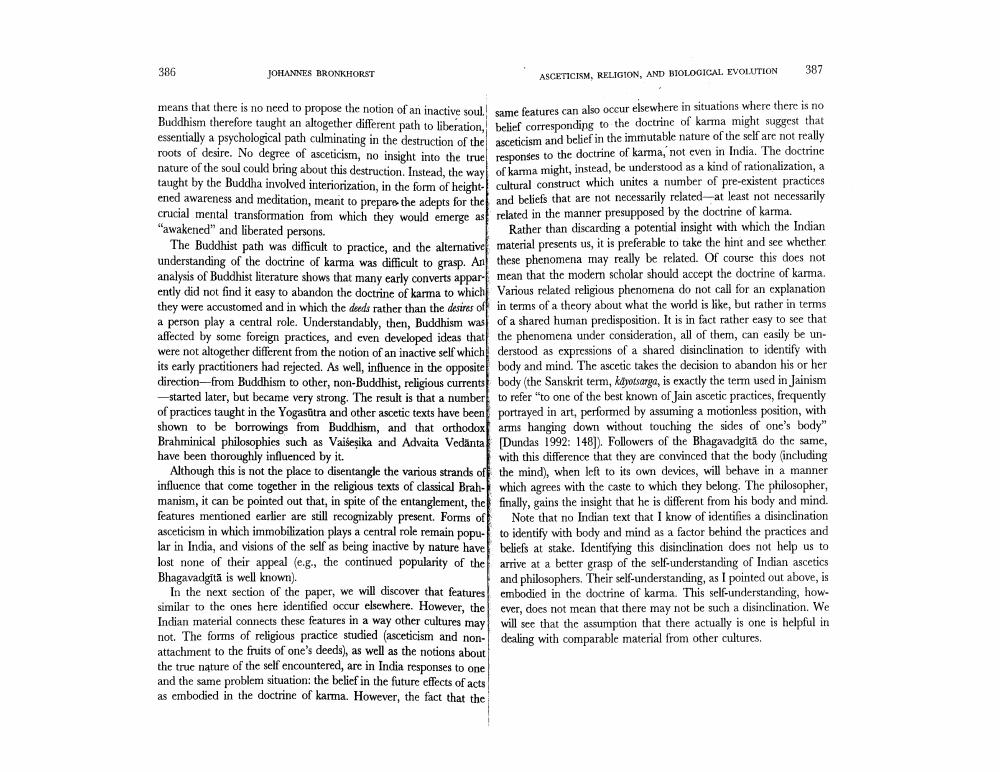Book Title: Asceticism Religion And Biological Evolution Author(s): Johannes Bronkhorst Publisher: Johannes Bronkhorst View full book textPage 7
________________ 386 JOHANNES BRONKHORST means that there is no need to propose the notion of an inactive soul. Buddhism therefore taught an altogether different path to liberation, essentially a psychological path culminating in the destruction of the roots of desire. No degree of asceticism, no insight into the true nature of the soul could bring about this destruction. Instead, the way taught by the Buddha involved interiorization, in the form of heightened awareness and meditation, meant to prepare the adepts for the crucial mental transformation from which they would emerge as "awakened" and liberated persons. The Buddhist path was difficult to practice, and the alternative understanding of the doctrine of karma was difficult to grasp. An analysis of Buddhist literature shows that many early converts apparently did not find it easy to abandon the doctrine of karma to which they were accustomed and in which the deeds rather than the desires of a person play a central role. Understandably, then, Buddhism was affected by some foreign practices, and even developed ideas that were not altogether different from the notion of an inactive self which its early practitioners had rejected. As well, influence in the opposite direction from Buddhism to other, non-Buddhist, religious currents -started later, but became very strong. The result is that a number of practices taught in the Yogasutra and other ascetic texts have been shown to be borrowings from Buddhism, and that orthodox Brahminical philosophies such as Vaišeșika and Advaita Vedanta have been thoroughly influenced by it. Although this is not the place to disentangle the various strands of influence that come together in the religious texts of classical Brahmanism, it can be pointed out that, in spite of the entanglement, the features mentioned earlier are still recognizably present. Forms of asceticism in which immobilization plays a central role remain popular in India, and visions of the self as being inactive by nature have lost none of their appeal (e.g., the continued popularity of the Bhagavadgitä is well known). In the next section of the paper, we will discover that features similar to the ones here identified occur elsewhere. However, the Indian material connects these features in a way other cultures may not. The forms of religious practice studied (asceticism and nonattachment to the fruits of one's deeds), as well as the notions about the true nature of the self encountered, are in India responses to one and the same problem situation: the belief in the future effects of acts as embodied in the doctrine of karma. However, the fact that the ASCETICISM, RELIGION, AND BIOLOGICAL EVOLUTION 387 same features can also occur elsewhere in situations where there is no belief corresponding to the doctrine of karma might suggest that asceticism and belief in the immutable nature of the self are not really responses to the doctrine of karma, not even in India. The doctrine of karma might, instead, be understood as a kind of rationalization, a cultural construct which unites a number of pre-existent practices and beliefs that are not necessarily related at least not necessarily related in the manner presupposed by the doctrine of karma. Rather than discarding a potential insight with which the Indian material presents us, it is preferable to take the hint and see whether these phenomena may really be related. Of course this does not mean that the modern scholar should accept the doctrine of karma. Various related religious phenomena do not call for an explanation in terms of a theory about what the world is like, but rather in terms of a shared human predisposition. It is in fact rather easy to see that the phenomena under consideration, all of them, can easily be understood as expressions of a shared disinclination to identify with body and mind. The ascetic takes the decision to abandon his or her body (the Sanskrit term, kayotsarga, is exactly the term used in Jainism to refer "to one of the best known of Jain ascetic practices, frequently portrayed in art, performed by assuming a motionless position, with arms hanging down without touching the sides of one's body" [Dundas 1992: 148]). Followers of the Bhagavadgită do the same, with this difference that they are convinced that the body (including the mind), when left to its own devices, will behave in a manner which agrees with the caste to which they belong. The philosopher, finally, gains the insight that he is different from his body and mind. Note that no Indian text that I know of identifies a disinclination to identify with body and mind as a factor behind the practices and beliefs at stake. Identifying this disinclination does not help us to arrive at a better grasp of the self-understanding of Indian ascetics and philosophers. Their self-understanding, as I pointed out above, is embodied in the doctrine of karma. This self-understanding, however, does not mean that there may not be such a disinclination. We will see that the assumption that there actually is one is helpful in dealing with comparable material from other cultures.Page Navigation
1 ... 5 6 7 8 9 10 11 12 13 14 15 16 17 18 19 20 21 22 23
